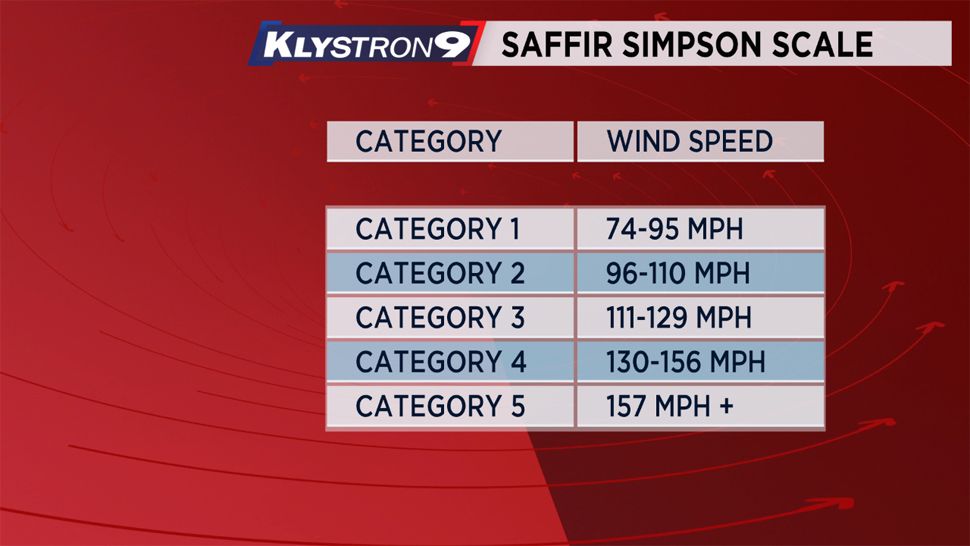TAMPA, Fla. -- With Hurricane Florence fresh in our minds, I wanted to discuss the categories of hurricanes, because some things troubled me relating to how residents in harm’s way in the Carolinas interpreted the scale.
First, what are the categories?
The Saffir-Simpson Hurricane Wind Scale is a rating system based on a hurricane’s sustained wind speed. The scale is predominantly used to estimate potential damage to property.
Category 3, 4, and 5 are considered "major" hurricanes because of the potential for significant damage and potential for loss of life. Category 1-2 are, however, still dangerous storms, as they are hurricanes.
Below is the wind scale from NOAA and a brief description of potential damage from that type of wind.
- Category 1: (74-95 mph) Very dangerous winds will produce some damage: Well-constructed frame homes could have damage to roof, shingles, vinyl siding and gutters. Large branches of trees will snap and shallowly rooted trees may be toppled. Extensive damage to power lines and poles likely will result in power outages that could last a few to several days.
- Category 2: (96-110 mph) Extremely dangerous winds will cause extensive damage: Well-constructed frame homes could sustain major roof and siding damage. Many shallowly rooted trees will be snapped or uprooted and block numerous roads. Near-total power loss is expected with outages that could last from several days to weeks.
- Category 3: (major) (111-129 mph) Devastating damage will occur: Well-built framed homes may incur major damage or removal of roof decking and gable ends. Many trees will be snapped or uprooted, blocking numerous roads. Electricity and water will be unavailable for several days to weeks after the storm passes.
- Category 4: (major) (130-156 mph) Catastrophic damage will occur: Well-built framed homes can sustain severe damage with loss of most of the roof structure and/or some exterior walls. Most trees will be snapped or uprooted and power poles downed. Fallen trees and power poles will isolate residential areas. Power outages will last weeks to possibly months. Most of the area will be uninhabitable for weeks or months.
- Category 5: (major) (157 mph or higher) Catastrophic damage will occur: A high percentage of framed homes will be destroyed, with total roof failure and wall collapse. Fallen trees and power poles will isolate residential areas. Power outages will last for weeks to possibly months. Most of the area will be uninhabitable for weeks or months.
Here is the main point. The category of a hurricane is based on the wind speed only, and not just the wind speed, but the maximum sustained wind speed.
That means, that if a storm has hurricane winds that extend outward 50 miles from the center, that at the very least somewhere in that wind radius is wind speed at that level. It does NOT necessarily mean that all of the winds within that radius are constantly blowing at that level.
Remember also, that the wind radius is mostly over water, and winds will almost always be stronger over water due to a lack of friction to slow down the wind.
Wind only one part of impact
As we all know and we just saw from Florence (and many other storms throughout history), wind and the potential damage from wind is only one part of the storms impact.
There is, of course, storm surge and heavy rainfall, both of which involve water. And moving water can be far more destructive and deadly than wind.
This is why it is important to not just focus on the category of the storm. It is important to listen to a trusted source for weather information so you know what the potential impact in your area will be from a storm.
When Florence was about 36 hours from really impacting the North Carolina Coast, it was a Category 4 storm, but it was showing some signs of weakening. It dropped to a Category 2 the next day and eventually made landfall as a Category 1 hurricane.
I was hearing some reports that people who were ordered to evacuate coastal and surge prone areas of North Carolina the day before were trying to return because it “was just a Category 2.” Those areas were going to see potentially destructive storm surge even as a weaker storm.
Counter to that, there have been hurricanes in the past that were of a higher category that produced very little storm surge due to their angle of approach to the coastline, or size of the storm, or other factors.
One of the challenges we face is that a lot of people get their information quickly from an app or one of their friends share a graphic on social media. Often times, without context, it is very difficult to make proper decisions on what to do.
Every storm is different. Each storm has different hazards and impacts that will affect different people. This is why it is crucial to have a reliable source for the context, the details, to communicate those potential impacts properly and calmly going forward through this and each future hurricane season.
Here at Spectrum Bay News 9, we do our best to deliver that message properly and effectively. We are very active on social media during dangerous weather situations.
With that all said, right now, the tropics are quiet.



